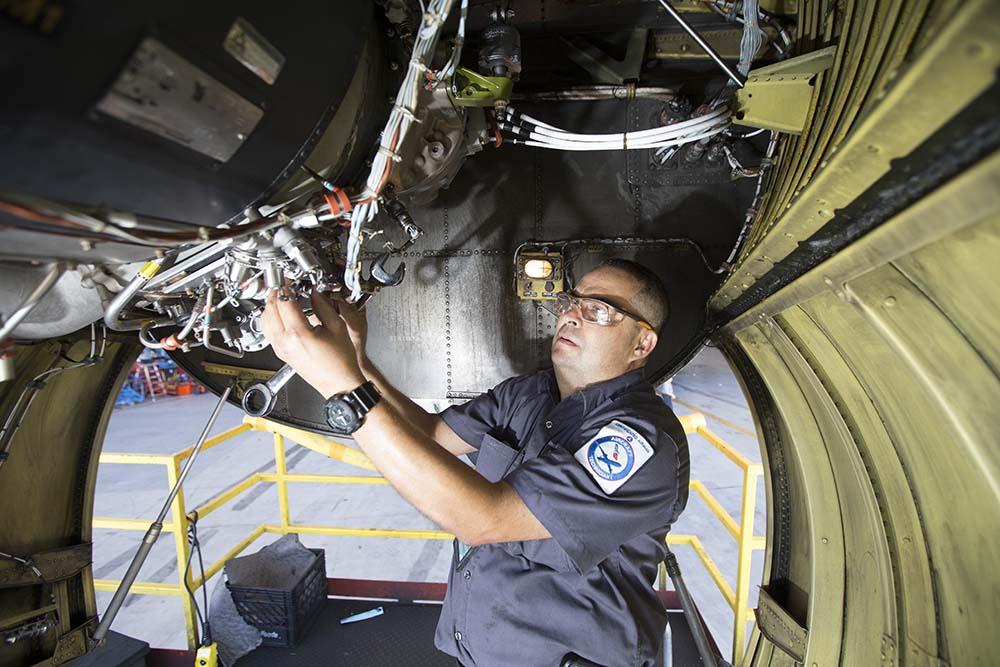
CHICAGO—Artificial intelligence is already driving many efficiencies within aircraft maintenance, with airlines using sensor data to improve maintenance planning and leveraging computer vision to log maintenance events and faults. Now, American Airlines is calling on the aftermarket to embrace natural language processing (NLP) to improve efficiency and safety.
During a presentation on Oct. 6 at Aviation Week’s Aerospace IT conference, Tassio Carvalho, American Airlines’ senior manager of operations research, explained four areas in which it is exploring the use of NLP for aircraft maintenance.
The first, and likely most well-known area, is using NLP to instantly enter and transcribe maintenance information using speech recognition. “It’s been used for ages in call centers, so we want to be able to do the same thing for the mechanic,” says Carvalho.
In this scenario, a mechanic with a tablet would be able to describe his or her maintenance findings or actions and this data would be automatically transcribed in a digital format. However, Carvalho says “it’s a slightly more complicated problem because the mechanic is not in a controlled environment, so the sound could have a lot of background noise.” He also points out that this use case for NLP is based on pre-trained language models, built by companies such as Microsoft and Google, but these would need to be customized “because the mechanic’s English is not the same English we speak on a daily basis.”
These pre-trained language models could also be used for more accurate identification of which ATA codes should be used to classify faults during maintenance. Today, mechanics write a description of a fault they have encountered, perform an ATA classification, initiate a repair and write up their actions. This is followed by a correction or review process to ensure the ATA code matches the fault.
“If we use some prediction to figure out what the ATA code is, then we can use it in two different ways: We can offer the mechanic the opportunity to have some recommendation as they type what the fault is or use it in the correction or the review code at the end,” says Carvalho.
NLP could also be used to make the process of searching for the appropriate corrective actions simpler and more intuitive. For instance, Carvalho says in a use case where a technician has performed a repair several times and “many times the repair doesn’t seem to stick,” they could use NLP to show which repairs have previously worked to resolve that specific fault. NLP could also be used to create auto-complete functionality, similar to what is used during web searches. However, he says this would need to “be better for MRO” and able to map English terms to standard technical terms.
Despite their potential benefits, Carvalho says pre-trained language models do provide some challenges. “I like to call some of the models that have been developed to understand language ‘English in a box,’ because they have, through computer logic and numbers, modeled the relationship among all the words in the English language,” he says. “But the pre-calibrated models don’t fully work for mechanics, so you have to do some recalibration to enrich that with the mechanic’s language.”
Carvalho says there are several methods airlines could use to improve the language data set. First, they could create synthetic data, which entails taking a real example and creating fabricated versions that are similar but slightly different. Airlines could also collaborate using a technique called federated learning. For example, Carvalho says a Boeing 737 aircraft operator could record data from its own mechanics, then pass the model along to other operators of the same aircraft type to build up the data set. “The data never changes hands, but the model becomes better as it’s calibrated with the language of mechanics of different airlines. In the end, everyone wins because the industry has a model that works for everyone,” he says.
Carvalho also stresses that airlines need to be more open-minded about technology that may not be 100% perfect right out of the gate. “If it’s never good enough, it’s never going to be implemented,” he says. “You have to be accepting of not-so-great quality sometimes, because that can help you improve the results as you put something into production.”
According to Carvalho, American Airlines has either completed or started trialing each of the aforementioned NLP use cases. The airline has both investigated third-party NLP products and developed some functionality in-house based on open-source technology. Carvalho also notes that American Airlines sees “a wealth of applications” for NLP in the customer service segment, such as processing complaints within a call center.





